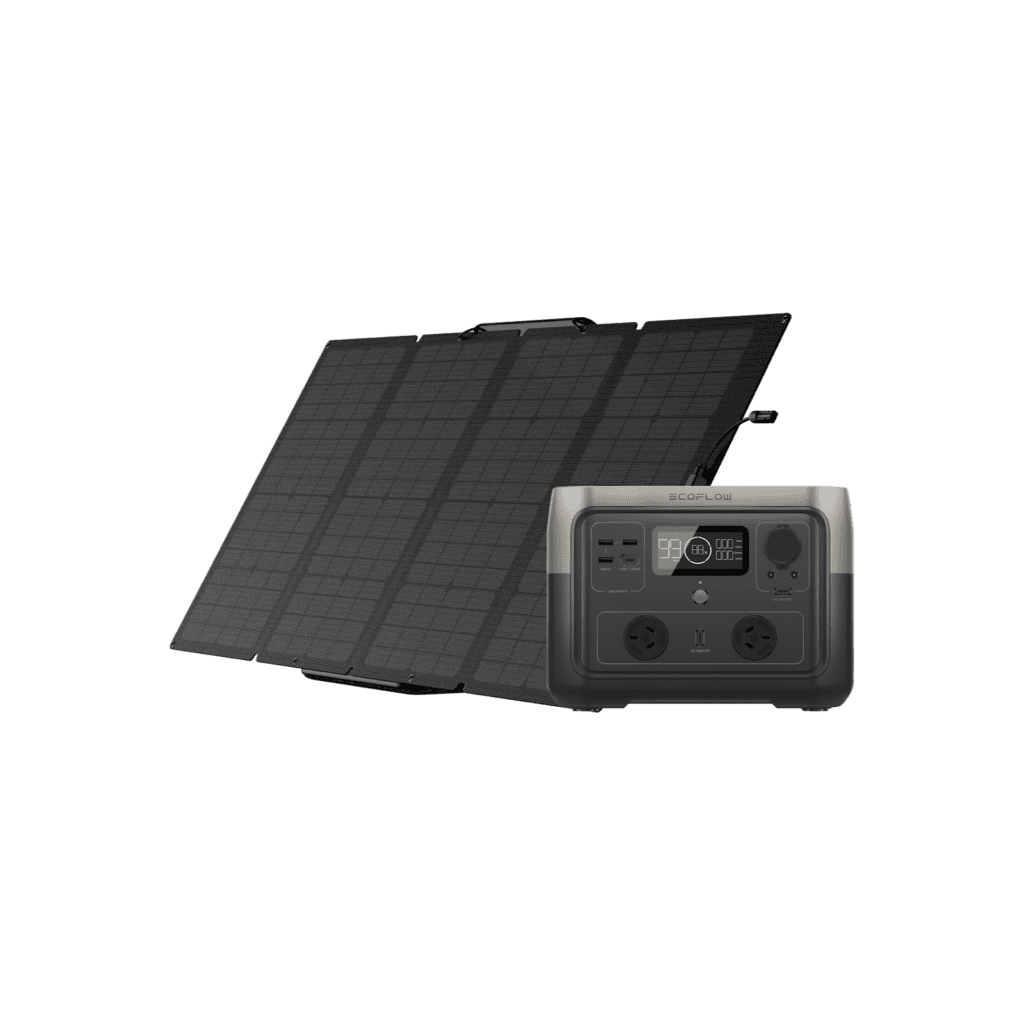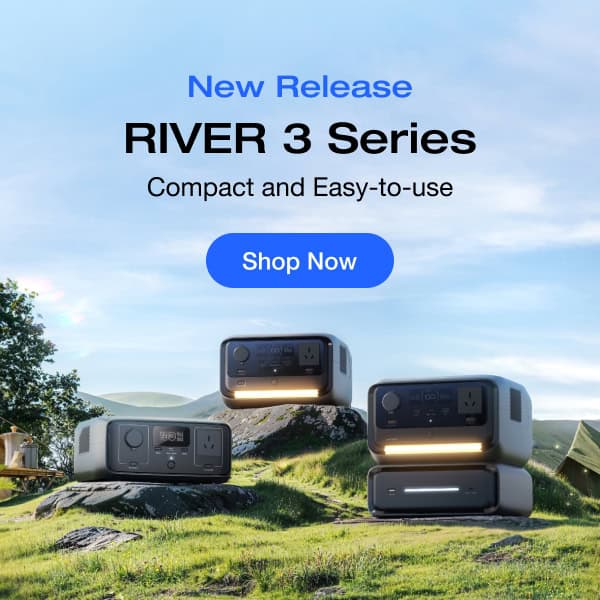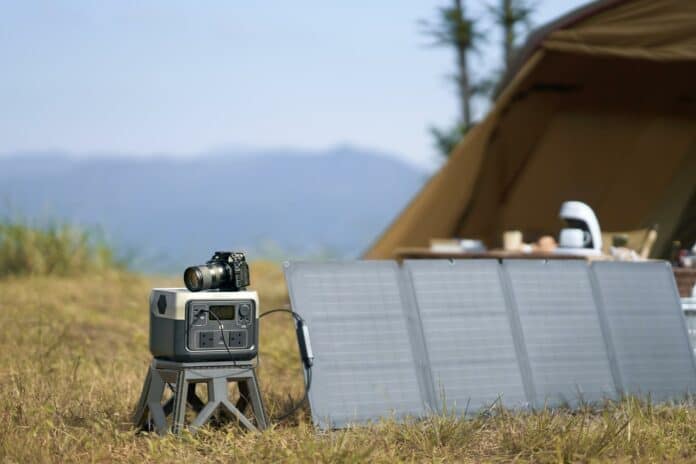Getting set up with solar power for camping is much easier than you may think. Whether this is your first introduction to solar energy or you’re wondering how to select the right kit for your next camping adventure, this guide will help.
Customising your solar power system for camping should always start with your requirements in mind. Here are the steps you need to take to make the right choice.
1. Determine Your Power Needs
First, you must estimate your energy usage to ensure the solar generator you invest in is suitable for your electricity needs. Take into account all the appliances or devices you expect to use on your trip. From there, you can do some quick and easy calculations to estimate your energy consumption in kilowatt-hours.
Let’s use an example. Say you’re taking lighting with you on your trip. You need to calculate how much energy your lights will consume each day. Multiply the combined watts of your lighting system by the number of hours you expect to use it. Finally, divide the total by 1000. The formula is as follows:
kWh = (watts x hours) divided by 1000
It’s helpful to understand what a kilowatt-hour equates to. One kilowatt is equal to 1000 watts of power, and one kilowatt-hour is equal to 1000 watts of energy for one hour.
If applicable, you also need to take into account the surge watts. Surge power refers to how much electricity is required to get your appliance up and running in the first place. Many appliances need additional power for just a few seconds when you first turn them on.
The formula is as follows:
Watts = Volts x Amps
Additional surge watts required are estimated at 1-2 times the running wattage, which is also usually found on the device itself.
2. Pick the Right Site
Choosing a good camping spot is one crucial factor of a successful trip. Another is choosing the best place for your solar panels.
You have two basic options. If you camp in a motorhome, you could mount rigid and flexible solar panels onto the vehicle’s exterior. Or, if you’re travelling on foot or don’t have a dedicated vehicle for camping, a portable power station (PPS) with portable solar panels is your best bet. Manufacturers like EcoFlow also sell portable solar panels and a PPS as a bundle, creating a solar generator.
If you have a fixed solar installation on your motorhome or van, park in a non-shaded area to ensure you get direct sunlight. With portable solar panels, it’s easy to position them to ensure you receive the maximum amount of sun — you even change the angle over the course of the day.
3. Choose Your Components
Here are the main components you will need for a functional solar power system:
- Solar panel(s)
- Solar battery
- Inverter
- Solar regulator — sometimes referred to as a charge controller.
EcoFlow’s solar generators come with all the necessary components in one plug-and-play package. You simply need to position the portable solar panels, and you’re good to go.
If you decide to go the DIY route, you will need to decide on the number and size of your panels and the capacity and compatibility of all the other required pieces of your kit.
Your running power requirement calculations will help you estimate the sizes of the solar panels and batteries you need.
4. Build the Battery House
Going DIY? You can use most materials to construct a battery box/ compartment. The battery housing is needed to protect your battery from the elements and any small hands — especially if you’re camping with the family.
Most batteries need a form of temperature control. Plus, cheaper batteries require you to add some form of ventilation to prevent the build-up of hydrogen gas. The other equipment involved, except the panels, should also be able to fit into this box.
You can also buy battery cases outright.
5. Install the Panels
Here’s where you must decide between a fixed installation using rigid and flexible solar panels or a fully portable solar panel setup. Permanent installations are typically only suitable for motorhome/van camping and household installation.
Many solar panels designed to be installed permanently come with framing or hooks to facilitate installation. Generally, it requires minimal handyperson skills to install the panels.
If you’re considering a motorhome installation, EcoFlow’s modular Power Kits might be the perfect choice for you. You can even use an online calculator to determine the kind of system you need based on the size of your vehicle, power consumption, and more.
Portable solar panels require no installation, just place them on the ground or anywhere that receives direct sunlight.
6. Wire Up the System
Wiring can be as simple as plugging the solar panels into a solar generator and pressing the on switch. However, the wiring can be challenging for someone without much electrical experience if you’re going the DIY route.
If you’re using components from different manufacturers, it’s essential to ensure they are all compatible with each other. The wiring instructions will vary significantly based on your choice of parts and solar panels.
If you’re installing more than one solar panel, you’re looking at a solar array. So, three 110-watt panels would equate to a 330-watt solar array. Wiring the panels in series will typically use less wire and save you money.
7. Enjoy Your Free Power!
You’re ready to go! Solar energy is a reliable alternative to traditional power sources. You can save yourself money, save the planet and power your appliances all at the same time.
Best Solar Panels for Camping
There are three main types of solar panels. The most common panels are made from crystalline silicon in two different forms: monocrystalline and polycrystalline. Monocrystalline panels tend to be more expensive as they’re more efficient.
The other common form of solar panels is made from amorphous silicon — often referred to as thin film panels. They are often the cheapest choice but are considerably less efficient. Thin film panels do offer some positives due to their flexibility. They are also often foldable because the material is so thin.
Rigid Solar Panels
A rigid solar panel for use on top of motorhomes and caravans is a perfect choice. The EcoFlow 400W Rigid Solar Panel is installation ready. The pre-drilled slots on the edges of the panels make it easy to secure the panel to your van roof.
EcoFlow’s high-quality monocrystalline rigid solar panels promise consistent efficiency and performance for years to come. The rigid design ensures durability even when met with challenging weather conditions, and because they’re roof-mounted, you can generate solar energy even when you’re on the road.
Portable Solar Panels
The EcoFlow 110W Portable Solar Panel will keep you powered off-grid without the need for permanent installation. They’re made with efficient monocrystalline silicon cells. Designed with rubber handles and flexible bracket stands — as well as a convenient carrying case — EcoFlow Portable Solar Panels eliminate the need for fixed installation.
Solar Generators

EcoFlow’s River 2 solar generators are small enough that they can be held in one hand, making them highly portable while providing ample off-grid power. The River 2 series is the best choice for hikers and those camping on foot. They provide the power you need without weighing you down.

The EcoFlow Delta 2 Solar Generator + 220W Portable Solar Panel is a popular bundle for those who need additional power. Plug in the bifacial solar panels and receive up to 500W with the ability to reach full charge within 3 – 6 hours.
X-Boost rapid charging makes the DELTA 2 a perfect addition to your next camping adventure. It’ll undoubtedly make camping more of a glamping experience.
Why leave your devices and appliances at home when you can stay powered wherever you are?
Final Thoughts
No matter what your energy needs while camping, there’s a solar power solution that’s right for you. For further details on the solar panel systems for camping available from EcoFlow, visit the website today.
People Also Ask
Are Solar Panels Worth It for Camping?
Most definitely. Solar panels allow you to travel wherever you want and always have access to power. You could take an even longer trip and work remotely from some beautiful locations. Plus, you can save even more money when camping by avoiding on-site shore power fees.
Pros
- More freedom to camp at a greater variety of locations
- Become a more independent and self-sufficient camper
- You can charge your solar generator with AC power ahead of time before you embark
How Many Solar Panels Do I Need For Camping?
The number of solar panels you need for camping ultimately depends on your power requirements.
It’s important to factor in the time of day you plan on using your equipment. If you’re using electrical lighting, this would typically be in the evening. Your solar panels won’t capture solar power at night, so this is when you’d use the energy that’s already been stored throughout the day.
If you’re draining the battery below 50% each evening, investing in a solar generator or battery with a larger capacity is better.
Can A Solar Panel Run a Camping Fridge?
They can! As long as your panels capture enough stored power to last overnight. Camping coolers and fridges run on about 40Watts.
How Long Do Portable Solar Panels Last?
Solar panels typically have a lifespan of more than 25 years, according to the United States Environmental Protection Agency.
The exact answer depends on numerous factors. This includes the type of panel you choose, how you install your system, the weather and climate they’re exposed to, and how you maintain your panels. With the proper care, solar panels can last even longer.
Many solar panel manufacturers issue warranties guaranteeing the panels for multiple years.
NREL research tells us that the average rate of degradation is 0.5% per annum. This means that the efficiency and production of your solar panel will decrease by 0.5% every year. By year 20, the panel is producing around 90% of the power it delivered in the first year of purchase.


